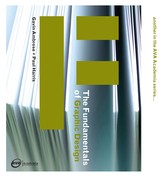
Job No:01077 Title:The fundamentals og Graphic Design
2ND
Proof Page:56
56 The Fundamentals of Graphic Design Influences and creative elements
Agency vs designer standpoint
The ethical position of a design agency, a designer
and a client should all come to light during the
interview stage, as all parties seek to establish
whether there is a good fit among them.
Ethics may cause problems when a design agency
accepts a commission for a company or product that a
designer is ethically opposed to, such as work on
alcohol, cigarette or animal fur brands. As the
anti-consumer lobby grows, designers often find
themselves caught between the two sides as their job
involves making products look more appealing. More
and more designers question their involvement in
promoting products or services that they deem
ethically or morally questionable.
Designers have a key role to play in creating the
visual fabric of the world around us and are
instrumental in producing the cultural tapestry that
binds us together as a society. This ultimately comes
with responsibility for the outcomes of design.
Charity vs paid work
There is the perception that work performed for
charities is donated or undertaken for free. This is not
always the case as charities, like any other business,
realise that they get what they pay for. Most large,
successful charities are run as businesses, and they
procure design in the same way as any other firm.
For a charity to operate successfully, it needs to
use design as a tool to convey the very specific
messages that it thinks are important in order to stir
people and create the social leverage they require to
effect change.
While some agencies may choose to work for
reduced fees (or even for free) for charities or causes
they support, such work is rarely free. Payment could
take other forms and may not always be tangible.
Agencies can receive positive publicity that extends
to a wider population, cultural kudos for supporting
specific values and, in some cases, they may have
greater creative freedom than with corporate clients.
However, this could also close the door to working
with companies that the charity may be targeting.
Social responsibility
Within the design industry there is a trend to
question ethical standpoint in relation to worldwide
issues such as gender, poverty and global warming.
Organisations increasingly foster and promote their
own ethical positions to guide their activities, which
can result in conflict with personal ethics.
024-071 01077_C1.qxd 8/21/08 10:12 AM Page 56

Job No:01077 Title:The fundamentals og Graphic Design
3RD
Proof Page:57
024-071 01077_C3.qxd 9/24/08 1:08 PM Page 57
Job No:01077 Title:The fundamentals og Graphic Design
3RD
Proof Page:57
Recycled paper
Recycled papers are those produced
using 100 per cent recovered fibre,
which may be pre- or post-consumer,
such as waste paper.
Vege t able in k s
Ink made from linseed and
soya vegetable oils that have been
developed to replace oil-based
printing inks, which are less toxic
and easier to remove than traditional
pigment transfer vehicles. This
eases de-inking during the paper
recycling processes.
Individual responsibility
As individuals we consciously and unconsciously
attempt to influence the moral behaviour of others.
As a designer, this may come in the form of
encouraging clients to use less packaging; issuing
smaller format publications; using recycled paper
instead of heavily filled art paper; sending HTML
emails rather than a printed material version; or
reducing the number of overs allowed for in the print
run, which may eventually end up in a landfill site.
One school of thought believes that fewer, but
higher-quality products should be produced so that
people will keep them for longer in order to move
away from the disposable culture that our society has
readily adopted. Junk mail or bulk mail is considered
a nuisance by an increasing proportion of the
population, and it may only be a matter of time before
designers and the studios they work for are unwilling
to contribute to this communication channel that
generates a huge amount of waste.
Identity and branding < Social responsibility > Modernism and postmodernism 57
Neal’s Yard Remedies (left)
This tea packaging was produced
using recycled paper and vegetable inks
to provide many benefits. The unbleached
paper is stronger than bleached paper,
which means that less packaging is
required, weight is reduced and
transportation costs are lowered.
The cellophane window is made from
eucalyptus rather than plastic.
We will change a broken world
(below)
NB: Studio’s poster for the charity
Christian Aid features a simple, yet
stark, graphic that aims to jolt people
and raise awareness.
024-071 01077_C3.qxd 9/24/08 1:08 PM Page 57
..................Content has been hidden....................
You can't read the all page of ebook, please click here login for view all page.
